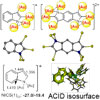Synthesis of tetra- and octa-aurated heteroaryl complexes towards probing aromatic indoliums

Polymetalated aromatic compounds are particularly challenging synthetic goals because of the limited thermodynamic stability of polyanionic species arising from strong electrostatic repulsion between adjacent carbanionic sites. Here we describe a facile synthesis of two polyaurated complexes including a tetra-aurated indole and an octa-aurated benzodipyrrole. The imido trinuclear gold(I) moiety exhibits nucleophilicity and undergoes an intramolecular attack on a gold(I)-activated ethynyl to generate polyanionic heteroaryl species. Their computed magnetic properties reveal the aromatic character in the five-membered ring. The incorporation of the aurated substituents at the nitrogen atom can convert non-aromaticity in the parent indolium into aromaticity in the aurated one because of hyperconjugation. Thus, the concept of hyperconjugative aromaticity is extended to heterocycles with transition metal substituents. More importantly, further analysis indicates that the aurated substituents can perform better than traditional main-group substituents. This work highlights the difference in aromaticity between polymetalated aryls and their organic prototypes.
http://www.nature.com/ncomms/2016/160517/ncomms11489/full/ncomms11489.html
